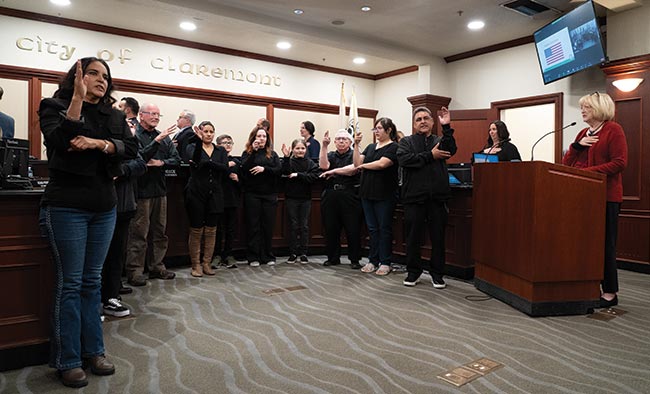Council approves housing element report, moves to preserve history

Students from the International Language School for Children and Adults, led by former Claremont Mayor Karen Rosenthal, right, recite the Pledge of Allegiance in American Sign Language during Tuesday’s City Council meeting. Courier photo/Andrew Alonzo
By Andrew Alonzo | aalonzo@claremont-courier.com
Housing Element progress report
The Claremont City Council voted unanimously Tuesday to adopt the 2023 annual housing element progress report ahead of an April 1 state deadline from the Department of Housing and Community Development and its Office of Planning and Research.
The report outlines the city’s progress in issuing building permits for the construction of housing units of all income levels for calendar year 2023, shows the city’s progress in planning for future housing units to address its regional housing needs allocation number, and contains data on the implementation status of housing programs in the fifth cycle housing element for 2023.
So far 160 — including 38 very low income, 21 low income, 7 moderate income, and 94 above moderate income — of the 1,711 new housing units Claremont has been tasked by the state to build have been permitted for the sixth cycle planning period of 2021 to 2029.
The state is requiring Claremont to plan for 1,711 units across four income categories: 556 (32%) extremely low and very low, 310 (18%) low, 297 (17%) moderate, and 548 (32%) above moderate in total. The city was allocated the 1,711 figure “as its fair share of the 1,341,827 total number of units needed to meet the forecasted population growth of the six-county Southern California Association of Governments (SCAG) region,” read a staff report. The SCAG region encompasses Imperial, Los Angeles, Orange, Riverside, San Bernardino and Ventura counties.
Last year’s number of housing units for which discretionary applications were submitted and deemed complete, as well as construction plans submitted for plan check, included 259 units: 60 very low income, 30 low income, 17 moderate income, and 152 above moderate income.
Net new housing units in 2023 that received either entitlement, a building permit, and/or final inspection included 978 units: 65 very‐low income, 35 low income, 136 moderate income, and 742 above moderate income.

John Neiuber, Chair of Claremont Architectural Commission, speaks in favor of the cultural resource preservation ordinance at Tuesday’s City Council meeting. Courier photo/Andrew Alonzo
There was nothing to report in the 2023 categories of sites identified or rezoned; commercial development bonuses approved by the city; units rehabilitated, preserved and acquired for alternative adequate sites; above moderate units converted to moderate income units; developments for lower income students; locally owned or controlled lands declared surplus or excess; or ones that have been sold, leased or otherwise disposed of. Units were also not reported in the tenant preference policy category since the city does not have such a policy that supports affordable housing projects financed through low-income housing tax credits and/or tax-exempt private activity bonds.
The annual progress report also included a status update on the following housing implementation programs: about $146,650 of American Rescue Plan Act funding was authorized to reinstate the community based organization grant program, which allocated $86,650 general services and $60,000 for homeless services; four low income senior households in the Claremont Villas and 138 tenants were assisted through the city’s ARPA‐funded temporary housing stabilization and relocation program; six low income older adults and one family were helped through the family and senior emergency fund; 62 unhoused people in Claremont were served, temporary housing was coordinated for eight families, and five individuals were moved into permanent housing using Tri‐City Mental Health Services Community Navigator program; a 15‐unit permanent supportive housing and affordable development for seniors, Claremont Gardens, broke ground at 956 W. Base Line Rd. in December 2023; and building permits were issued for Larkin Place, a 33‐unit permanent supportive housing project on Harrison Avenue spearheaded by Jamboree Housing Corporation, in June 2023.
The planning commission reviewed the 2023 report at its March 19 meeting and recommended the City Council approve it Tuesday. The adoption and certification process for the sixth-cycle housing element, dated from 2021‐2029,is in progress and will be sent to the planning commission and city council in the coming months.
The annual progress report is a crucial component of Claremont’s Housing Element that includes a demographic profile of the city, an analysis of opportunities and constraints for the development of new housing, and an evaluation of existing housing programs, wrote Public Information Officer Bevin Handel in an email.
“Additionally, the Housing Element Update (HEU) also sets forth new implementation programs to facilitate the creation of new housing opportunities in the City and to protect the City’s existing affordable housing stock,” Handel wrote. “Housing Elements are required by the state and must be updated every four to eight years.”
Preservation Ordinance
Also on Tuesday’s agenda was the first reading of the cultural resources preservation ordinance, which will change the way Claremont preserves its history.
The ordinance will not only rename the city’s architectural commission to the architectural and preservation commission, but also brings a number of changes to the city’s municipal code. Among them are amendments of requirements to be on the renamed commission, and changes to the commission’s duties, design review criteria, and procedures.
It will also alter building conservation and demolition guidance and appeals procedures for staff on the commission, and add a new chapter to the city’s municipal code, “cultural resources preservation.”
Chris Veirs, Claremont’s principal planner, spent much of Tuesday’s meeting going over the municipal code’s new chapter, section 16.302, which outlines the ordinance’s intent, key definitions, purpose, and goals; staff, architectural preservation committee, and council review responsibilities; criteria and procedures for designating resources; the mandatory review for demolition of structures over 45 years old; certificates of appropriateness procedures; review criteria and conditions for approving certificates of appropriateness; an economic hardship and wavier for imminent threat; required cultural resources maintenance; economic incentives; and enforcement and penalties.
Unless exceptionally important, federal guidelines indicate a building or landmark should be more than 50 years old to be designated historic. City staff recommended using 45 years to avoid overlooking important resources and to keep in line with other California cities’ historic criteria.
Before the ordinance can go into effect however, city staff will need to overcome a few more hurdles. Claremont will need to apply to become a certified local government through the California State Office of Historic Preservation. This will make the city eligible for state grants to support implementation of the ordinance and historic maintenance. The city also needs to draft application and permit forms and guidance materials; adopt design guidelines for the city’s various neighborhoods and the various types of architecture that are prevalent throughout Claremont; develop city specific guidelines for preservation of resources listed in the secretary of interior standards document for the treatment of historic properties; consider a citywide cultural resources survey; and add or remove resources from the Claremont register.
If adopted, the ordinance could go into effect as early as May 9, 30 days after the council would have read the act for a second time. The ordinance was supported by a council appointed ad hoc committee, the planning and architectural commissions, and Claremont Heritage.










0 Comments